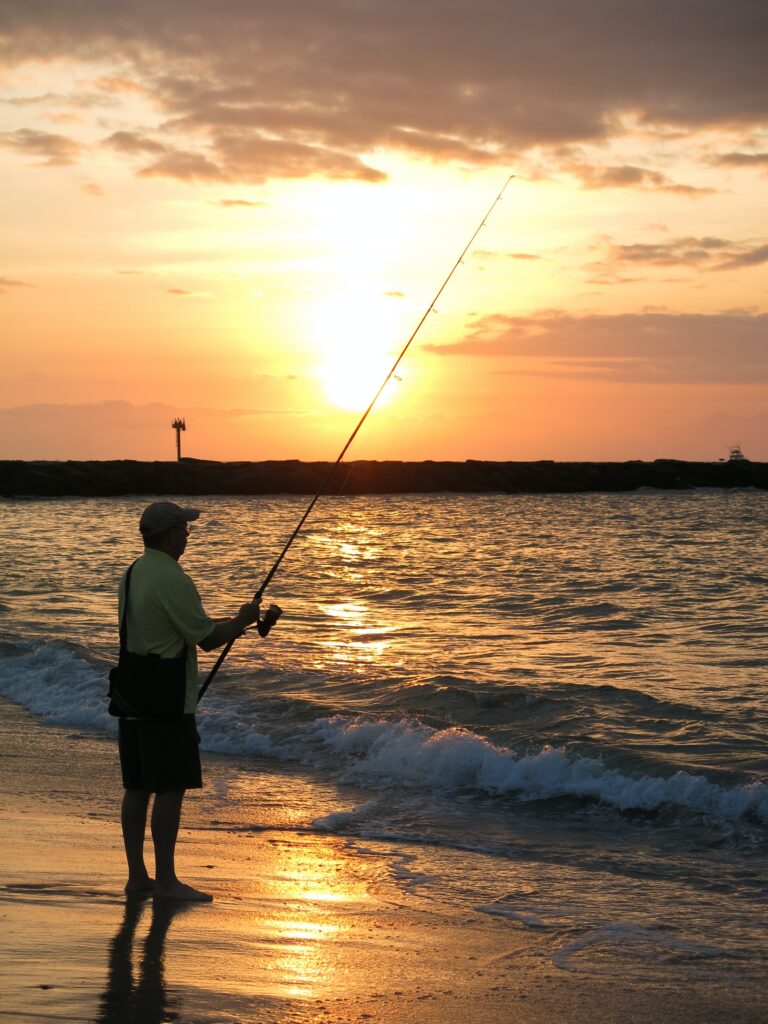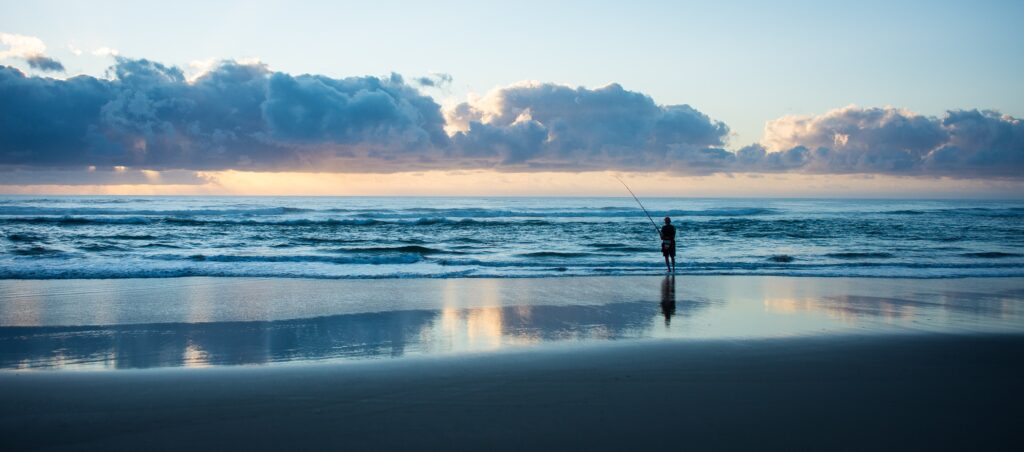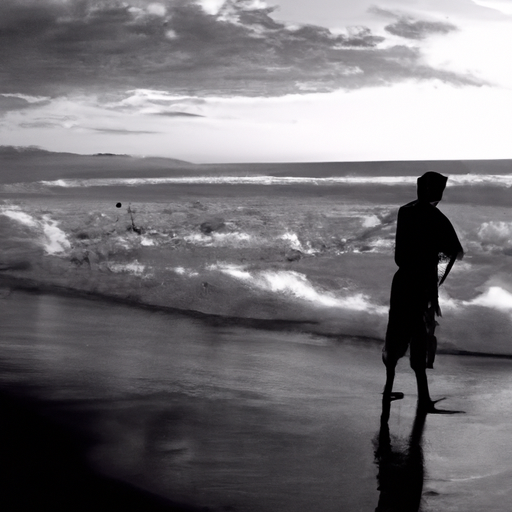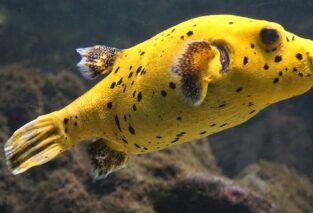Surf fishing is an exciting and rewarding way to fish, but if you’ve never tried it before, you may be wondering if it’s something you can do. “Can You Go Surf Fishing: Tips and Techniques for Fishing from the Beach” is here to help answer that question. Packed with valuable information and expert tips, this comprehensive guide will provide you with the knowledge and skills you need to tackle surf fishing with confidence. Whether you’re a novice angler or a seasoned pro, this article will help you navigate the challenges and reap the rewards of surf fishing.

Types of Fish to Target
Popular fish species for surf fishing
When it comes to surf fishing, there is a wide variety of fish species that you can target. Some of the most popular species include striped bass, bluefish, redfish, flounder, and snook. These fish are known for their strong fighting abilities, making them a popular choice among anglers. Additionally, species like pompano, whiting, and croaker are also common catches in the surf.
Best bait and lures for each species
Choosing the right bait or lure is crucial when targeting specific fish species in the surf. For striped bass and bluefish, a popular choice is using fresh bait such as live eels, bunker, or mackerel. Artificial lures like topwater plugs and metal spoons are also effective for enticing these predatory species. Redfish and flounder, on the other hand, prefer natural baits like live shrimp or crab, as well as soft plastic jigs.
For catching snook, live bait such as pilchards or mullet is highly effective. Artificial lures such as swimbaits and jerkbaits can also attract snook successfully. When targeting pompano, using sand fleas, shrimp, or clam strips as bait is recommended. Whiting and croaker, on the other hand, are attracted to shrimp, bloodworms, or sand fleas.
Tips for locating fish in the surf
Locating fish in the surf can sometimes be a challenge, but there are a few tips that can help increase your chances of success. Look for areas where waves are breaking, as fish often gather to feed in these turbulent waters. Pay attention to changes in water color and look for baitfish activity, as predatory fish are likely to be nearby. Consider fishing around piers, jetties, or any other structures that provide cover for fish. Finally, do some research and ask local anglers or bait shops for advice on the best fishing spots in the area.
Essential Gear for Surf Fishing
Choosing the right fishing rod and reel
When it comes to surf fishing, investing in a sturdy and long fishing rod is essential. A surf fishing rod typically ranges from 9 to 12 feet in length, providing the necessary casting distance and power to handle larger fish. Look for a rod with a medium-heavy to heavy power rating, as this will ensure the strength needed to handle the surf’s rough conditions. Pair your rod with a spinning reel that has a high line capacity, as surf fishing often requires using heavier lines.
Must-have tackle and accessories
In addition to a quality rod and reel, there are several must-have tackle items and accessories for surf fishing. A tackle box with a variety of hooks, sinkers, and swivels is crucial for rigging your bait or lures. It’s also important to have a selection of artificial lures, such as plugs, spoons, or soft plastics, to cover a range of fishing scenarios. Other essential accessories include a fishing knife, a bait bucket or cooler to keep your bait fresh, and a fishing cart or backpack to transport your gear easily.
Appropriate clothing and footwear for beach fishing
Proper clothing and footwear are important for comfort and safety during surf fishing. Wear lightweight and breathable clothing that protects you from the sun, such as long-sleeved shirts and pants made of UV-protective fabric. Don’t forget a wide-brimmed hat and polarized sunglasses to shield your eyes from the sun’s glare. When it comes to footwear, opt for sturdy sandals or water shoes that can handle sandy and wet conditions. Additionally, consider wearing a wading belt and a personal flotation device (PFD) for added safety if you plan on wading into deeper waters.

Understanding Tides and Currents
The impact of tides and currents on surf fishing
Tides and currents play a crucial role in surf fishing, affecting fish behavior and feeding patterns. As the tide rises and falls, it creates movement in the water, which can attract fish. Fish often move closer to the shore during high tide, making it an ideal time to fish. On the other hand, during low tide, fish might be more spread out and concentrated in deeper channels. Understanding how tides and currents impact the surf will help you determine when and where to fish for the best results.
How to read tide charts and understand tidal movements
Reading tide charts is essential for planning your surf fishing trips effectively. Tide charts provide information on the expected water levels throughout the day, allowing you to identify high and low tide periods. Pay attention to the times and heights of the tides, as well as their relationship to sunrise and sunset. This information will help you determine the best times to fish and locate productive fishing spots along the shoreline.
Techniques to fish effectively during different tidal phases
During different tidal phases, adjusting your fishing techniques can greatly improve your chances of success. During high tide, fish tend to move closer to the shore to feed, so casting closer to the breaking waves can be productive. Use lures or baits that imitate local forage species to attract fish in this scenario. During low tide, fish might be concentrated in holes, troughs, or deeper channels. Experiment with different casting distances and retrieve speeds to find where the fish are actively feeding.
Casting and Presentation Techniques
The different casting techniques for surf fishing
Mastering different casting techniques is key to effectively fish in the surf. Two commonly used techniques are the overhead cast and the off-the-ground cast. The overhead cast involves bringing the rod back over your shoulder and casting forward using a smooth and powerful motion. The off-the-ground cast, also known as the pendulum cast, is useful for achieving longer casting distances. It involves swinging the rod back and using your body’s momentum to propel the bait or lure forward.
Tips for achieving distance and accuracy in your casts
To achieve greater distance and accuracy in your casts, start by ensuring your rod and reel are properly balanced and suited for long-range casting. Practice your casting technique regularly, focusing on generating speed and power in your cast while maintaining control. Utilize the momentum of your body by stepping forward as you cast to increase the distance. Experiment with different casting weights and lures to find what works best for your setup.
Presenting your bait or lure in a natural and enticing way
Presenting your bait or lure in a natural and enticing way is crucial for attracting fish in the surf. When using bait, make sure it is securely attached to your hooks and any excess line is removed to avoid tangling. Cast your bait into the surf and let it settle on the bottom, mimicking the natural behavior of prey. If using lures, vary your retrieve speed and experiment with different actions to imitate injured or fleeing baitfish. Remember to be patient and observe the water for any signs of fish activity.

Choosing the Right Spot for Surf Fishing
Identifying productive fishing spots on the beach
Identifying productive fishing spots on the beach requires some observation and understanding of fish behavior. Look for areas where there are changes in the water’s depth or structure, such as sandbars, troughs, or channels. These areas often provide cover and food sources for fish. Pay attention to any breaking waves or rip currents, as they can indicate areas where fish are actively feeding. Additionally, look for any visible signs of baitfish activity, such as birds diving or baitfish jumping out of the water.
The importance of structure and underwater features
Structure and underwater features play a significant role in attracting and holding fish. Fish are often drawn to areas with changes in the bottom contour, such as sandbars or rocky structures. These structures create turbulence and provide cover for baitfish, which in turn attract larger predatory fish. Additionally, submerged vegetation or structures like jetties and piers can be hotspots for finding fish. Understanding the underwater topography of your fishing area will greatly enhance your chances of success.
Factors to consider when selecting a fishing location
When selecting a fishing location, there are several factors to consider. Firstly, assess the prevailing wind direction and choose a spot that provides some wind protection. Wind can create waves and turbulence that make casting and presenting your bait more challenging. Secondly, consider the accessibility of the spot and whether you can comfortably fish from there. Look for areas with ample space for casting and maneuvering your gear. Lastly, check for any local fishing regulations, as some areas may have restrictions or seasonal closures.
Safety Precautions and Etiquette
Tips for staying safe while surf fishing
Staying safe while surf fishing is of utmost importance. Always be aware of your surroundings and keep an eye on the ocean’s conditions. Avoid fishing during severe weather or strong currents, as this can be dangerous. Be cautious of slippery rocks or uneven terrain when fishing from jetties or rocky shores. It’s also advisable to fish with a buddy or let someone know about your fishing plans. Lastly, remember to wear a hat, use sunscreen, and stay hydrated to protect yourself from the sun’s harmful rays.
Respecting other beachgoers and sharing the space
When surf fishing, it’s important to respect other beachgoers and share the space. Be mindful of other anglers and give them enough space to cast and move without interfering. If fishing near swimmers, avoid casting near them to prevent any accidents or hooking incidents. Dispose of your trash properly and be considerate of the environment by minimizing your impact on the beach. Following proper etiquette ensures an enjoyable experience for everyone involved.
Understanding local regulations and fishing restrictions
Before heading out for surf fishing, familiarize yourself with the local fishing regulations and restrictions in your area. Check for any required fishing licenses or permits to ensure you are in compliance with the law. Some areas may have specific rules related to bag limits, size limits, or seasonal closures for certain fish species. Knowing and respecting these regulations not only keeps you on the right side of the law but also helps conserve fish populations and maintain sustainable fishing practices.

Techniques for Catching Fish from the Surf
Bottom fishing and surf rig setups
Bottom fishing is a common technique used in surf fishing, especially when targeting species like striped bass and flounder. To set up a bottom fishing rig, start by attaching a pyramid sinker or a bank sinker to the mainline. Tie a swivel to the end of the mainline and connect a fluorocarbon leader. Attach your hook to the leader, making sure it is suitable for the bait you are using. This setup allows your bait to settle on the bottom, where bottom-dwelling fish are likely to be.
Tips for catching fish in the surf zone
When fishing in the surf zone, it’s important to consider the location of the fish and their feeding patterns. Cast your bait or lure beyond the breakers and allow it to drift with the current or waves towards the beach. This mimics the natural movement of baitfish and can entice predatory fish to strike. Be patient and maintain a steady retrieve or gently twitch your bait to attract attention. Keep an eye out for any signs of fish activity, such as birds diving or fish jumping, as these can indicate areas where fish are actively feeding.
Strategies for targeting specific species of fish
To target specific species of fish, it’s important to understand their behavior and feeding habits. Research and learn about the preferred habitat, diet, and seasonal movements of the fish you are targeting. Adjust your fishing techniques, choice of bait or lures, and the location you fish accordingly. For example, if targeting striped bass, focus on areas near jetties or structures and use bait that mimics their primary forage, such as live eels or chunk baits. Experiment with different strategies until you find what works best for the species you are pursuing.
Tips for Handling and Releasing Fish
Proper techniques for handling fish caught in the surf
When handling fish caught in the surf, it’s important to do so with care to minimize injury or stress to the fish. Wet your hands before handling the fish to prevent damaging their protective slime coating. Use a landing net or gripper tool to lift the fish from the water, avoiding excessive handling. If you need to handle the fish directly, support their body with both hands and avoid squeezing or applying excessive pressure. Remove the hook gently using a pair of pliers or a hook remover, taking care not to harm the fish in the process.
Tips for safely releasing fish unharmed
Releasing fish unharmed is crucial for conservation and maintaining healthy fish populations. If the fish is exhausted or tired after the fight, gently hold it in the water facing into the current to help it recover. Alternatively, slowly move the fish back and forth in the water to ensure water flows through its gills and re-oxygenates properly. Once the fish shows signs of strength, release it gently back into the water. Avoid dropping or throwing the fish, as this can cause internal injuries. By handling and releasing fish properly, you contribute to the sustainability of the fishery.
Practicing catch and release to conserve fish populations
Catch and release practices are essential for preserving fish populations and ensuring the future of the sport. By releasing fish unharmed after they have been caught, you allow them to continue their reproductive cycle and contribute to the overall health of their species. When practicing catch and release, minimize the amount of time the fish spends out of water. Use barbless hooks or flatten the barbs to make hook removal easier and less damaging to the fish. Handle the fish gently and avoid unnecessary stress. By adopting responsible catch and release techniques, you become a steward of the environment and help protect our marine resources.

Surf Fishing in Different Seasons
Changes in fish behavior and availability throughout the year
Different seasons bring about changes in fish behavior and availability in the surf. In the spring, many fish species begin their migration, making it an excellent time for surf fishing. Striped bass, bluefish, and redfish are often more active during this time, as they move along the coast. Summer months offer a chance to target species such as flounder, snook, and pompano, which thrive in warmer waters. Fall is known for the arrival of migrating baitfish, attracting larger predatory fish to the surf. Winter can be a productive time for surf fishing as well, with species like striped bass and winter flounder being more active during this period.
Tips for adjusting your techniques for each season
To adjust your techniques for each season, it’s important to consider the specific behaviors and preferences of the fish during that time of year. Vary your choice of bait and lures based on what the fish are feeding on during that particular season. Pay attention to the water temperature and adjust your fishing depths accordingly. During colder months, fish may be more sluggish, so slowing down your retrieve and using scent-based attractants can be effective. Stay informed about local fishing reports and talk to local anglers to learn about the current fishing conditions and techniques that are working best.
Targeting seasonal species during their peak times
Certain fish species have peak seasons when they are more active and readily available in the surf. By targeting these species during their peak times, you can increase your chances of success. For example, striped bass are often more active during their spring and fall migrations, making these seasons ideal for targeting them. Snook tend to be more active during the summer months, particularly around dawn and dusk. Pompano can be targeted during the spring and fall, when they move along the coast in search of food. Understand the patterns and behaviors of the species you are targeting to plan your surf fishing trips accordingly.
Additional Tips and Tricks
Using scent attractants to improve your chances of success
Using scent attractants can significantly increase your chances of success in surf fishing. Many fish are attracted to the smell of certain foods or the scent of injured baitfish. Applying scent attractants to your bait or lures can make them more enticing to the fish, especially when visibility is poor or the water is murky. There are various commercially available scent attractants designed specifically for saltwater fishing. Apply a small amount to your bait or lures just before casting to enhance their effectiveness.
Avoiding common mistakes and pitfalls in surf fishing
Surf fishing can be challenging, especially for beginners. Avoiding common mistakes and pitfalls can greatly improve your overall experience. One common mistake is casting too close to the shore, missing out on potential fish farther out. Pay attention to your surroundings, using polarized sunglasses to look for fish activity and changes in the water. Another common mistake is using inappropriate tackle or line that is not suited for surf fishing. Investing in quality gear and using the proper line weight will greatly enhance your chances of success.
Developing patience and persistence for a successful fishing experience
Patience and persistence are two key qualities for a successful surf fishing experience. Fish may not always bite immediately, and it can take time to learn the nuances of surf fishing. Developing patience will allow you to wait for the right moment and increase your chances of landing a fish. Persistence is crucial when trying different techniques, baits, or locations. Not every day will result in a successful catch, but by persevering and learning from your experiences, you will become a more skilled and successful surf angler.
In conclusion, surf fishing offers a unique and exciting way to enjoy the ocean while pursuing various fish species. With the right gear, knowledge, and techniques, you can increase your chances of landing your target fish. Remember to always prioritize safety, respect the environment and regulations, and practice responsible catch and release to ensure the sustainability of our valuable marine resources. So grab your fishing rod, head to the beach, and enjoy the thrill of surf fishing!





